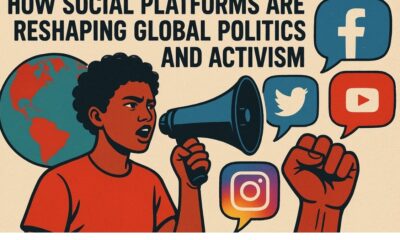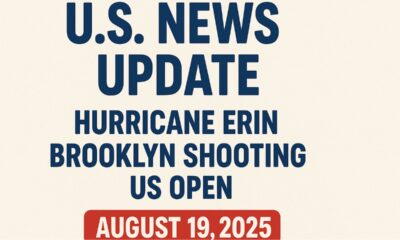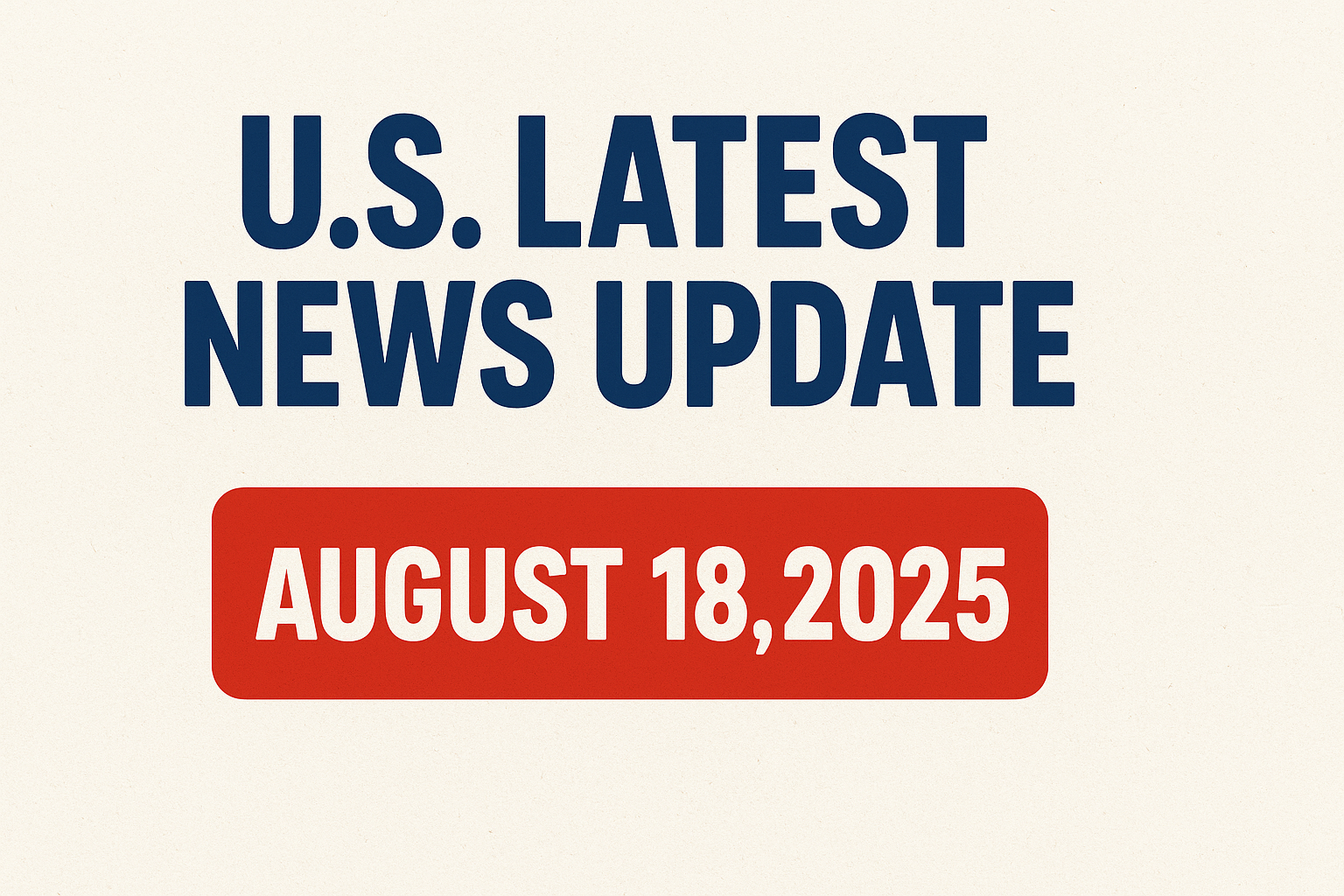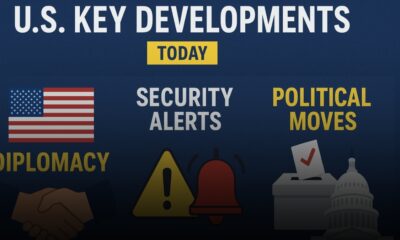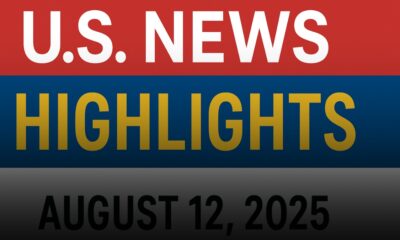Entertainment
U.S. Markets Slide as Trump’s Global Tariffs Drive Economic Jitters
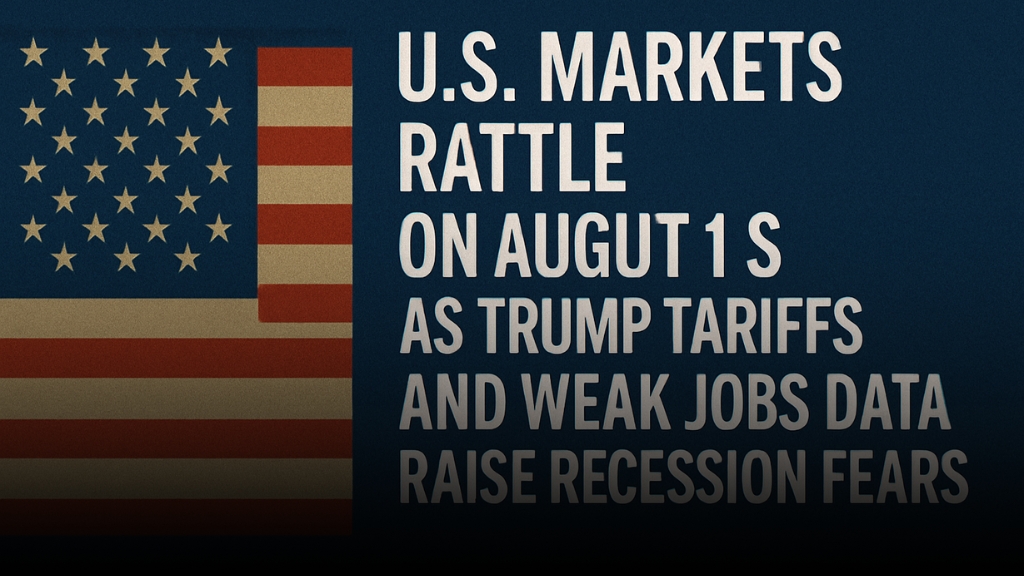
1. Introduction
On August 1, 2025, the United States entered a volatile economic phase as President Trump’s new wave of global tariffs collided with weaker-than-expected jobs data. The result? U.S. stock markets dipped, investors grew cautious, and questions about the country’s near-term economic stability intensified.
2. President Trump Imposes Broad Tariffs
President Trump signed an executive order enforcing tariffs between 10% and 41% on imports from over 90 countries. Key measures included:
- 35% tariffs on Canadian goods, citing national security and drug trafficking concerns.
- Tariffs on Brazil, India, and Taiwan are affecting steel, electronics, and agricultural imports.
- Negotiated exemptions for South Korea and Japan under strict review clauses.
These new duties are set to go into effect by August 7, 2025, causing a ripple of uncertainty across global trade partners and U.S. supply chains.
3. Stock Market Reaction
U.S. equity markets responded negatively in pre-market trading:
- Dow Jones Industrial Average futures fell by 1.1%
- S&P 500 futures dropped by 1.2%
- Nasdaq 100 saw a decline of 1.3%
The combined weight of trade conflict and slowing labor data pressured financial sentiment.
4. Weak Job Growth Adds Pressure
The July 2025 jobs report, released on the morning of August 1, revealed:
- Only 73,000 new jobs added (vs. forecast of 130,000+)
- The unemployment rate rose to 4.2%
- Manufacturing and retail sectors lost jobs, while healthcare and tech made modest gains.
These figures raised concerns that the U.S. labor market may be cooling, especially under the weight of high interest rates and uncertain trade policies.
5. Mixed Tech Earnings Influence Markets
Corporate earnings from major U.S. tech firms also played a role:
- Amazon stock fell over 8%, following a weaker-than-expected cloud services forecast.
- Apple stock rose nearly 2%, buoyed by strong services and wearables revenue, although executives warned of potential tariff-related profit erosion of up to $1.1 billion.
6. Consumer Sentiment and Inflation Signals
A University of Michigan survey released the same day showed:
- Consumer sentiment index rose slightly to 61.7, a sign of cautious optimism.
- Inflation expectations declined to 4.5%, down from 5.0% in June, which could ease some pressure on the Federal Reserve.
7. What Does It All Mean?
The convergence of new tariffs, disappointing job numbers, and corporate caution paints a picture of economic fragility.
| Indicator | Current Status | Implication |
|---|---|---|
| Job Growth | Slowing (73K added) | Potential risk to household spending |
| Trade Policy | Aggressive tariffs on 90+ nations | Global supply chain pressure |
| Market Performance | Stocks fell 1%+ | Weak investor confidence |
| Consumer Sentiment | Slightly improved | Public cautiously hopeful |
| Inflation Outlook | Cooling slightly | May lead to Fed rate cut later in 2025 |
8. Expert Analysis
Economic Strategists warn that if trade tensions escalate further while the labor market continues to soften, the U.S. could enter a recessionary period by Q4 2025.
Meanwhile, investors are shifting attention to the Federal Reserve’s next moves, as markets now price in a 67% chance of a rate cut in September.
9. Frequently Asked Questions (FAQs)
1. Why did markets drop on August 1, 2025?
Due to new tariffs announced by President Trump and weak job growth data.
2. What goods are affected by the new tariffs?
Metals, electronics, agricultural products, and auto parts from countries including Canada, India, and Brazil.
3. Will this increase consumer prices?
Yes. Tariffs raise import costs, which typically get passed on to consumers.
4. What’s happening in the job market?
Hiring slowed in July, especially in manufacturing and retail. The unemployment rate rose slightly.
5. Is the U.S. economy heading for a recession?
Not officially, but signals like job stagnation, tariffs, and cautious consumer behavior suggest growing risks.
6. Will the Federal Reserve respond?
A rate cut is possible if inflation continues to ease and job growth doesn’t rebound.
10. Conclusion
August 1, 2025, reflects a turning point for the U.S. economy. With global trade tensions rising, job growth slowing, and market uncertainty deepening, all eyes now turn to the Federal Reserve and how consumers respond. The next few weeks will be crucial in determining whether this is a passing storm—or the start of a deeper economic correction.
Entertainment
U.S. Key Developments | Today | Diplomacy, Security Alerts, and Political Moves

August 15, 2025, brought a series of significant developments in U.S. foreign policy, domestic politics, and security concerns. From high-profile summits with global leaders to emerging political strategies and security alerts, these events reflect America’s shifting role in international diplomacy while managing critical issues at home.
1. Trump–South Korea Summit Scheduled for August 25
The White House confirmed that President Donald Trump will host South Korean President Lee Jae Myung in Washington on August 25.
Focus Areas:
- Strengthening economic cooperation in semiconductors and energy transition
- Expanding defense ties in response to regional security threats
- Joint initiatives in advanced manufacturing and technology
This summit marks a crucial step in reinforcing U.S. alliances in the Indo-Pacific, particularly amid growing competition with China.
2. Trump–Putin Summit in Alaska on Ukraine Crisis
In a surprising diplomatic move, President Trump and Russian President Vladimir Putin will meet in Alaska to discuss the ongoing war in Ukraine.
Key Discussion Points:
- A potential territorial exchange to resolve the conflict
- Sanctions relief in exchange for verifiable security guarantees
- Russia’s role in broader global energy markets
This meeting has generated both optimism and skepticism, with analysts debating whether a lasting peace can be achieved.
3. U.S. Independence Day Greetings to India and Pakistan
The Biden administration delivered carefully crafted diplomatic messages for both India’s and Pakistan’s Independence Days.
- To India (August 15): A warm congratulatory note emphasizing democratic values and mutual security interests.
- To Pakistan (August 14): A more pragmatic message, focusing on cooperation in critical minerals and energy sectors.
This demonstrates Washington’s nuanced balancing act between two historical rivals in South Asia.
4. California’s Special Election on U.S. House Redistricting
Governor Gavin Newsom has called for a special election to redraw congressional maps in California.
Reason for the Move:
- Countering Republican-led redistricting efforts in Texas
- Protecting equitable political representation
- Addressing concerns over gerrymandering and voter fairness
This political development could set a precedent for other states facing similar challenges.
5. Bomb Threat at U.S. Embassy in Seoul
On South Korea’s Liberation Day, the U.S. Embassy in Seoul faced a bomb threat traced to a known hoax perpetrator.
Investigation Findings:
- No explosives found
- The alias used matched prior false alarm incidents
- Authorities emphasized vigilance and enhanced digital security monitoring
While no harm was caused, the event underscored the ongoing security challenges faced by U.S. diplomatic facilities abroad.
U.S. Developments on August 15, 2025
| Event | Key Details |
|---|---|
| Trump–South Korea Summit | Scheduled for Aug 25; focus on trade, technology, and security |
| Trump–Putin Summit | Talks on Ukraine peace and global energy markets |
| U.S. Independence Day Messages | Warm greeting to India; economic focus with Pakistan |
| California Redistricting Election | Special vote to redraw maps, counter Texas political strategies |
| Seoul Embassy Bomb Threat | False alarm; investigation highlights cyber-security threats |
Political and Strategic Implications
The timing of these events reflects the U.S. government’s multi-pronged approach to international relations:
- Diplomatic Engagement: Engaging both allies and adversaries to shape global outcomes.
- Domestic Safeguards: Protecting democratic processes through electoral fairness.
- Security Vigilance: Balancing cyber and physical security in a complex threat environment.
Conclusion
August 15, 2025, was a defining day for U.S. diplomacy and domestic politics. The announced summits, political maneuvers, and security alerts highlight the nation’s active role in shaping global developments while safeguarding democratic institutions at home. As these events unfold, their outcomes will likely influence both the 2025 political landscape and America’s international standing.
Entertainment
U.S. Tariff Truce | Heatwave | and Political Shifts
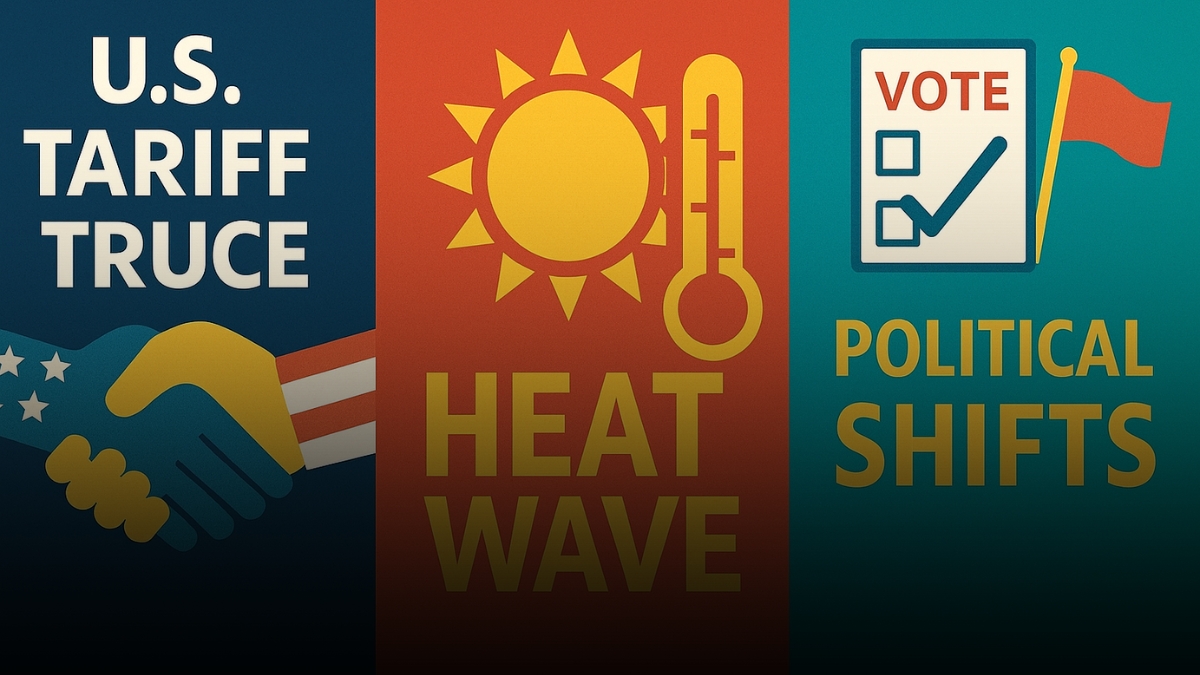
1. Tariff Truce Extended for 90 Days
The United States and China have agreed to extend their current tariff truce by another 90 days, preventing sharp increases in trade duties. This extension is intended to maintain stable trade conditions ahead of the holiday shopping season and has provided a boost to global market confidence.
2. New BLS Chief Picked Amid Data Integrity Debate
President Trump has nominated economist E.J. Antoni, affiliated with the conservative Heritage Foundation, as the new commissioner of the Bureau of Labor Statistics. The move comes after the unexpected dismissal of the previous commissioner and has sparked discussion over the potential politicization of U.S. economic data.
3. Intense Heatwave Spreads Across U.S.
A severe heatwave is affecting large parts of the United States, with the East Coast experiencing record-breaking highs across New England and the Mid-Atlantic. In the West, temperatures have soared above 110 °F, prompting health warnings and raising wildfire risks. Authorities caution that extreme heat conditions may persist.
4. South Africa Prepares Revised Trade Pitch
In response to heavy U.S. tariffs, South Africa is finalizing a revised trade proposal aimed at lowering the 30% duty imposed on many of its exports. The move seeks to reinvigorate stalled trade negotiations between the two countries.
August 12 Key U.S. Developments
| Topic | Key Insight |
|---|---|
| Tariff Truce Extended | U.S. and China delay tariff hikes by 90 days, calming markets |
| New BLS Nomination | Antoni chosen amid concerns over independence of official economic statistics |
| Nationwide Heatwave | Record-breaking temperatures raise public health and wildfire concerns |
| South Africa Trade Offer | Revised deal proposal aims to ease U.S. tariff pressure on exports |
Key Takeaways
- Trade Stability: The 90-day tariff extension offers breathing space for businesses while keeping the door open for further negotiations.
- Economic Data Oversight: The appointment of E.J. Antoni has stirred political debate about the credibility and independence of government-reported economic data.
- Climate Impacts: The ongoing heatwave highlights the intensifying effects of climate change and the need for improved emergency response systems.
- Global Diplomacy: South Africa’s revised trade bid underscores the impact of U.S. trade policy on emerging economies and the importance of maintaining open dialogue.
Entertainment
U.S. News Highlights | August 12, 2025

August 12, 2025, brought significant developments in U.S. economic policy, foreign diplomacy, energy markets, and domestic governance. From trade negotiations easing global tensions to planned strategic security talks, the day showcased America’s influence on both international and local fronts.
2. U.S.–China Tariff Truce Extended
The United States and China agreed to extend their existing tariff truce by 90 days, preventing a major escalation in import duties. This move comes as both sides seek to protect economic stability ahead of peak trading seasons.
Economic Impact:
- Avoids tariff hikes that could have affected billions in goods.
- Provides businesses with breathing space for supply chain adjustments.
- Signals potential for renewed high-level negotiations between the United States and China.
Details Table:
| Aspect | Information |
|---|---|
| Duration | 90 days |
| Purpose | Prevent tariff escalation |
| Markets Reaction | Positive – stocks and oil prices rose |
| Trade Volume Impact | Stabilization expected |
3. Asian Markets Respond Positively
Global investors reacted with optimism to the tariff extension. Japan’s stock market hit record highs, while other Asian markets posted steady gains.
Market Drivers:
- Technology sector growth.
- Weak Australian interest rates are supporting investment.
- Confidence in U.S.–China trade stability.
Details Table:
| Market | Reaction |
|---|---|
| Japan Nikkei Index | Record high |
| Hong Kong Hang Seng | Moderate gains |
| Shanghai Composite | Slight increase |
4. Oil Prices Climb on Trade Relief
Crude oil prices rose as easing trade tensions reduced fears of global demand disruptions. Investors also looked ahead to upcoming U.S. inflation data and the Trump–Putin summit.
Price Overview:
- Brent crude: modest increase.
- WTI crude: mirrored Brent’s gains.
Details Table:
| Factor | Impact on Oil |
|---|---|
| Trade truce | Boosted demand outlook |
| Inflation data wait | Investors cautious |
| Geopolitical talks | Added market stability |
5. U.S.–South Korea Summit Planned for August 25
President Donald Trump will meet South Korean President Lee Jae Myung in Washington to discuss security cooperation and economic ties.
Key Discussion Areas:
- Semiconductor production.
- Renewable energy transition.
- Critical technology investments.
- Defense funding and military cooperation.
Details Table:
| Aspect | Information |
|---|---|
| Date | August 25, 2025 |
| Location | Washington, D.C. |
| Main Topics | Security, economy, tech |
| Strategic Impact | Strengthens U.S.–Korea ties |
6. Federal Takeover of D.C. Police Sparks Outcry
President Trump’s decision to take control of the D.C. Metropolitan Police Department and deploy 800 National Guard troops drew sharp criticism.
D.C. Mayor Muriel Bowser and several civil rights leaders labeled the move as unconstitutional, while legal challenges are already underway.
Details Table:
| Aspect | Information |
|---|---|
| Action Taken | Federal control of D.C. police |
| Troops Deployed | 800 National Guard soldiers |
| Main Criticism | Unconstitutional overreach |
| Legal Response | Lawsuits filed |
7. Summary of August 12, 2025 Developments
| Topic | Key Insight |
|---|---|
| Tariff Truce Extended | Stabilizes trade, boosts markets |
| Asian Markets Rally | Technology and investment growth |
| Oil Prices Rise | Eased trade tensions improve demand outlook |
| U.S.–Korea Summit | Focus on tech, energy, and defense |
| D.C. Police Federal Control | Sparks legal and political controversy |
8. Conclusion
The events of August 12, 2025, highlight the U.S.’s role as both a stabilizing and polarizing force in world affairs. Economic diplomacy, energy market reactions, strategic security partnerships, and domestic governance decisions all played a role in shaping the day’s headlines. The coming weeks will determine whether these developments lead to long-term stability or renewed tensions.

